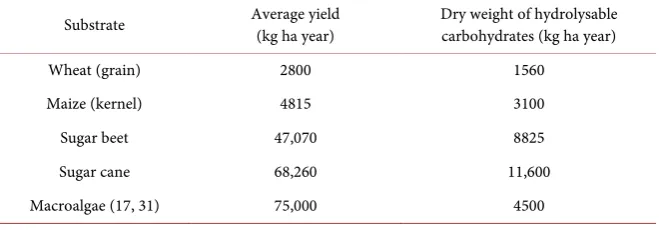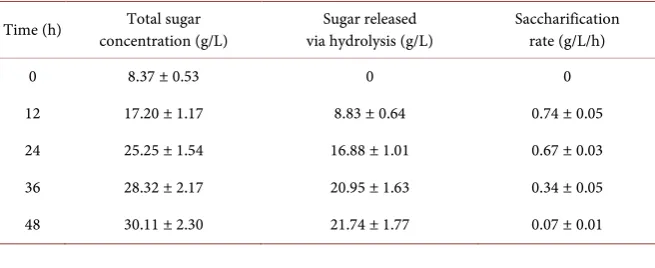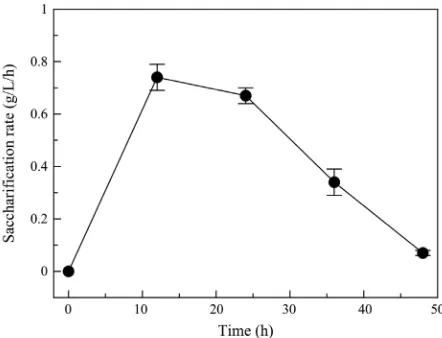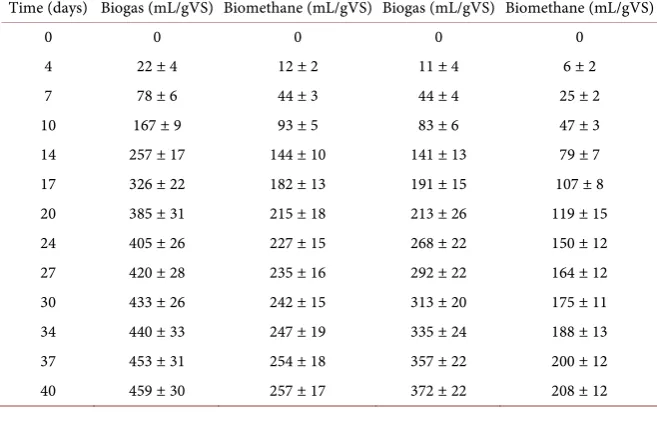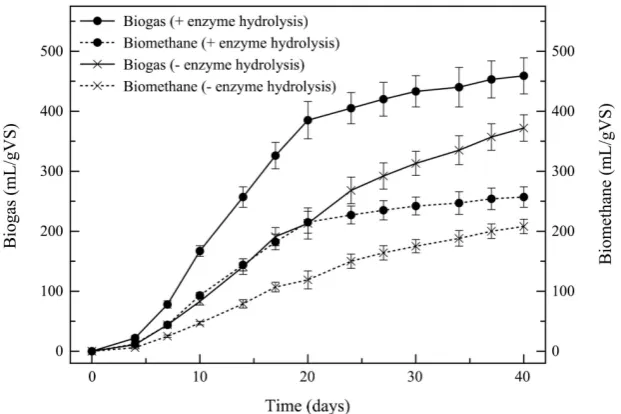ISSN Online: 2165-3410 ISSN Print: 2165-3402
DOI: 10.4236/aim.2019.94021 Apr. 19, 2019 359 Advances in Microbiology
Carbohydrate Yield and Biomethane Potential
from Enzymatically Hydrolysed
Saccharina
latissima
and Its Industrial Potential
Jacob J. Lamb
1,2*, Dag R. Hjelme
1, Kristian M. Lien
21Department of Electronic Systems & Enersense, NTNU, Trondheim, Norway
2Department of Energy and Process Engineering & Enersense, NTNU, Trondheim, Norway
Abstract
The demand for fuel for utilisation of machinery and transport has culmi-nated in large amounts of fossil fuel usage in the last century. The environ-mental dangers attached with the usage of fossil fuels have created a large demand for alternative sources of fuels. There is an array of polysaccharides contained within macroalgae, such as mannitol, cellulose and laminarin. These polysaccharides have potential for production of alternative biofuels; however, they are not easily accessible for biological digestion. By pretreat-ment of macroalgae with enzymes, these polysaccharides may be easier to ac-cess by microbes, allowing effective utilization in anaerobic digestion. Sac-charina latissima, available in abundance on the Norwegian coast line, is a brown macroalgae with a high level of carbohydrates. This study assesses the ability for utilisation of enzymatically pre-treated Saccharina latissima for production of biogas through anaerobic digestion. The harvested Saccharina latissima was analysed to contain 30.11 ± 2.30 g of reducing sugars per 100 g of dry sample upon enzymatic hydrolysis. This was able to yield 459 ± 30 mL per gVS of biogas through anaerobic digestion, with a methane content of 56%. This suggests a biomethane potential of 1760 m3 per ha of productive sea floor growing Saccharina latissima. An evaluation of this process has been performed to demonstrate the industrial potential of Saccharina latissima in biogas production.
Keywords
Macroalgae, Hydrolysis, Biogas, Biomethane, Enzymatic Hydrolysis
1. Introduction
The development of alternative fuels to reduce the requirement of fossil fuel
us-How to cite this paper: Lamb, J.J., Hjelme, D.R. and Lien, K.M. (2019) Carbohydrate Yield and Biomethane Potential from En-zymatically Hydrolysed Saccharina latis-sima and Its Industrial Potential. Advances in Microbiology, 9, 359-371.
https://doi.org/10.4236/aim.2019.94021
Received: March 22, 2019 Accepted: April 16, 2019 Published: April 19, 2019
Copyright © 2019 by author(s) and Scientific Research Publishing Inc. This work is licensed under the Creative Commons Attribution International License (CC BY 4.0).
DOI: 10.4236/aim.2019.94021 360 Advances in Microbiology
age have become of increased interest in recent decades; however, the produc-tion of alternative fuels like biofuels is economically unfavourable compared to the fossil fuel market. Despite this, many biofuels (e.g., bioethanol, biogas and biodiesel), are promising alternatives due to their potential sustainability and low environmental impact [1] [2] [3] [4]. Furthermore, many of these biofuels can be utilised by conventional means (e.g., internal combustion engines) when supplimented with fossil fuels [5]. Biogas is a renewable fuel that is already util-ised globally as an alternative to fossil fuels, being able to be injected directly into pre-existing natural gas networks. Currently, the majority of biogas production relies on the utilisation of biological waste products as the substrate (e.g., agri-cultural waste & food industry waste), meaning for many years it has been con-sidered a waste-to-energy route. Although there is still opportunity for signifi-cant increases in production from these waste products, other areas of unutilised biomass are of increased interest to extend from the waste-to-energy capacity, and towards a more global and high capacity model. Furthermore, to avoid utilisation of substrates that compete with food crops and require large amounts of land area [6] [7], unused biomass is of great interest, avoiding obstacles such as limited yields, geographic latitude, structural characteristics and high produc-tion costs [8].
[image:2.595.210.540.610.725.2]An alternative is to utilise marine biomass as a substrate, avoiding many of the problems observed in terrestrial substrates. Macroalgae are photosynthetic or-ganisms that utilise the solar irradiation to fix carbon for their metabolism forming rigid polysaccharide-based structures. They grow wild throughout the oceans on coastal areas, collecting significant quantities of polysaccharides that can be hydrolysed into simple polysaccharides for straight-forward utilisation in anaerobic digestion. Additionally, macroalgae tend to have a high content of solids ranging between 8.3% - 22% [9] [10] [11], reducing the requirement of thickening, dewatering and drying of the substrate. Macroalgae have a large area of productivity globally, high production rates per area (Table 1), do not com-pete with conventional food-based agriculture, do not require fertilization or ir-rigation, recycle ocean bicarbonate and are compatible with existing production streams and biorefineries [12] [13] [14]. The main drawback currently is the saccharification of microalgal biomass into anaerobically digestible polysaccha-rides for significant biogas production.
Table 1. Major bioethanol crops and macroalgae comparison (modified from (17, 36)).
Substrate Average yield (kg ha year) Dry weight of hydrolysable carbohydrates (kg ha year)
Wheat (grain) 2800 1560
Maize (kernel) 4815 3100
Sugar beet 47,070 8825
Sugar cane 68,260 11,600
DOI: 10.4236/aim.2019.94021 361 Advances in Microbiology
There is a significant lack of terrestrial agriculture production in Nordic countries due to the winter climate (low temperatures and light levels), where the production of biomass on land is a slow process. Here, the potential of food production from terrestrial agriculture cannot be reduced for production of biomass for biofuels. In these cases, macroalgae provide a significant alternative as a biomass source. The extensive coastline of Norway is a prime example, where the warm waters from the gulf stream provide the perfect growing condi-tions for macroalgae like Saccharina latissima, a carbohydrate-rich macroalge
[15] [16]. S. latissima contains the carbohydrates laminarin, mannitol and algi-nate in significant quantities, where laminarin and manitol serve as energy stor-age carbohydrates, and alginate as a rigid structural carbohydrate. Although laminarin and mannitol can be anaerobically digested by various microbes to produce biogas, alginate is rather challanging to hydrolyse, reducing its digesta-bility during biogas production.
Here, samples of S. latissima that were obtained from Trondheimsfjord in Norway have been assessed for their biogas production potential from there di-gestable carbohydrates. Using a carbohydrate extraction proceedure previously described [17], further easily digestable carbohydrates were obtained from the macroalgae. This allowed to biogas potential of S. latissima to be significantly increased, providing the foundation for its utilisation in the biogas industry in the Nordic countries.
2. Materials and Methods
2.1. Macroalgae Collection
S. latissima was collected from Trondheimsfjord (N63˚26'56'', E10˚10'48'') near Trondheim, Norway in August of 2017. The macroalgae were subsequently washed using tap water to remove particulates from the surface. S. latissima was then milled using a table-top blender with 10 mL of deionized water per 1 kg of macroalgae to produce a dense macroalgae pulp. The pulp was dried for 48 h at 30˚C and then stored in airtight plastic bags in a dry location for further use.
2.2. Algal Pulp Lysis
The dry macroalgae pulp (10% w/v) was suspended in 0.15 M sodium carbonate (Na2CO3) solution to a volume of 1 L at a starting pH of 9.0 in a stirred beaker for 2 h at 50˚C.
2.3. Enzymatic Hydrolysis
Commercial β-glucanase (G4423) from Trichoderma longibrachiatum (Sigma Aldrich, Germany) was used during enzymatic hydrolysis. This was an enzymatic mixture of β-1-3/1-4-glucanase, xylanase, cellulase, β-glucosidase, β-xylosidase,
DOI: 10.4236/aim.2019.94021 362 Advances in Microbiology
48 h at room temperature. Samples were taken every 12 h and analyzed for glu-cose concentration using a hexokinase gluglu-cose assay kit (GAHK20-1KT, Sigma, Germany).
2.4. Carbohydrate Characterization
Total carbohydrates, reducing sugar and glucose content were both determined by acidic treatment of pre-hydrolysis dry biomass. Biomass (0.5 g) was treated with 5 mL of 72% (v/v) H2SO4 at room temperature for 30 minutes with constant stirring via a magnetic stirrer. The sample was then diluted to a volume of 50 mL with deionized water, then autoclaved at 121˚C for 30 minutes. Once cooled, NaOH was added to the sample to reach a pH of 7.5. The total carbohydrates in the sample were then determined by using a phenol-sulfuric acid method [18]. Reducing sugars in the sample were determined using a dinitrosalicylic acid method [19]. Glucose content of the hydrolysate was determined using a hexo- kinase glucose assay kit (GAHK20-1KT, Sigma, Germany).
2.5. Inoculum
The microbial inoculum for the biomethane potential experiments was obtained from the Biokraft biogas plant (Skogn, Norway), from a large-scale continuous mesophilic multifuel anaerobic digester. Prior to the biomethane potential test, the inoculum was incubated at 39˚C to reduce endogenous biogas production. The inoculum was diluted to 9 g volatile solids (VS) per liter. The diluted inocu-lum had a pH of 7.5.
2.6. Biomethane Potential
The processed samples were digested anaerobically in sealed batch bottles. These were performed in triplicate with inoculum and processed samples, with inocu-lum alone as a control batch. The following was added as trace minerals and nu-trients: 10 mM NH4Cl, 8 mM NaCl, 1 mM CaCl2·2H2O, 0.5 mM MgCl2·6H2O and 0.3 mM Na2S·3H2O, as previously described [20]. The final liquid volume of each experiment was 250 mL. The bottles were flushed with nitrogen gas and closed with rubber septums and sealed as described by Ekstrand et al. [21]. These were incubated at 39˚C indefinitely with regular agitation.
2.7. Composition Analysis
DOI: 10.4236/aim.2019.94021 363 Advances in Microbiology
2.8. Gas Production Volume
Measurement of the produced gas volume was achieved using an optimised liq-uid displacement method. The volume of gas was then adjusted for temperature using Charles’s law.
2.9. Gas Composition and Calculation
Regular 10 mL samples of gas from each experiment were extracted for compo-sitional analysis. The composition was analysed using gas chromatography (SRI 8610C, SRI Instruments, USA), equipped with a thermal conductivity detector using hydrogen as the carrier gas. A standard mixture of CO2, CH4, H2 and N2 was used as a calibrating gas. Using the volume of gas calculated with the liquid displacement method, and the percentage of methane present in the samples, methane production was calculated for the experiments. All methane production levels are the average of 3 separate experiments and have been corrected by sub-tracting the endogenous methane production levels for the inoculum only ex-periments.
2.10. Statistical Data Analysis
All experiments within this study were conducted in triplicate with the results displayed as mean values ± the standard deviation.
3. Results
S. latissima is a naturally occuring macroalgae that has a fast growth rate and is found in many locations on the extensive Nordic coastline. With increasing de-mand for substrates for biomethane production, it seems logical to utilise this macroalgae due to the considerable amounts of carbohydrates it produces. By exposing the microalgae to an enzymatic hydrolysis pre-treatment, the increases in straight forwardly digestable carbohydrates is of great interest to the biogas industry.
3.1.
S. latissima
’s Carbohydrate Content
Using the collected samples of S. latissima, the total carbohydrates, reducing sugars and the glucose yield were determined (Table 2). These observations are similar to those previously obtained using the same methodology [17]. Before the enzymatic hydrolysis, the total carbohydrates consisted of 55% ± 3.1% of the dry weight of S. latissima. Furthermore, the reducing sugar content was 36% ± 1.9% of the dry weight, whereas the glucose content was 10% ± 1.8% of the dry weight of S. latissima. These observations of carbohydrate composition are in agreement with previously observed compositions of S. latissima, including studies of S. latissima obtained from Trondheimsfjorden [17] [23] [24] [25].
3.2. Enzymatic Hydrolysis of Polysaccharides from
S. latissima
DOI: 10.4236/aim.2019.94021 364 Advances in Microbiology
polysaccharides from S. latissima were extracted. The lysate was then altered to a neutral pH (pH 6) and exposed to an enzyme mixture of β-1-3/1-4-glucanase, xylanase, cellulase, β-glucosidase, β-xylosidase, α-˪-arabinofuranosidase, and amylases for a period of 48 h at room temperature. The reducing sugar concen-tration of the sample was measured every 12 h during the enzymatic hydrolysis process.
From the initial basic lysis of S. latissima, 8.37 ± 0.53 g/L of reducing sugars were released. Further enzymatic hydrolysis yielded a further 21.74 ± 1.77 g/L of reducing sugars after the 48 h incubation period (Figure 1; Table 3). The total reducing sugars obtained from the basic lysis and enzymatic hydrolysis was ob-served to be 30.11 ± 2.30 g/L of reducing sugars. When using the dinitrosalicylic acid method for determining total reduced sugars [19], the maximum amount of reducing sugars obtainable from the sample of S. latissima was observed to be 36% ± 1.9% of the dry weight of reducing sugars before the lysis and enzymatic hydrolysis. Therefore, the efficiency of this process was determined to be 83.6% of the maximum obtainable reducing sugars, which is in agreement with previ-ously observed results [17].
[image:6.595.208.538.484.567.2]With regard to the rate of the enzymatic hydrolysation of the polysaccharides from S. latissima, the maximum rate was observed at 12 h of incubation with the enzyme mixture (Figure 2; Table 3). The rate gradually declined after this pe-riod, as typically observed in similar studies [12] [17] [26] [27]. Although it has been speculated that the decline in rate of the enzymatic hydrolysis may be due to the inhibition of the enzymes by the liberated glucose and cellobiose [12] [27] [28], it may also be due to the reduction of functional enzyme units in relation to the reduced amount of complex polysaccharides left.
Table 2. Carbohydrate composition of S. latissima.
Carbohydrate
group Relative % of dry weight
Total carbohydrate 55 ± 3.1
Total reducing sugar 36 ± 1.9
Glucose (pre hydrolysis) 10 ± 1.8
Table 3. Hydrolysis yields from S. latissima.
Time (h) concentration (g/L) Total sugar via hydrolysis (g/L) Sugar released Saccharification rate (g/L/h)
0 8.37 ± 0.53 0 0
12 17.20 ± 1.17 8.83 ± 0.64 0.74 ± 0.05
24 25.25 ± 1.54 16.88 ± 1.01 0.67 ± 0.03
36 28.32 ± 2.17 20.95 ± 1.63 0.34 ± 0.05
[image:6.595.210.538.600.734.2]DOI: 10.4236/aim.2019.94021 365 Advances in Microbiology Figure 1. Enzymatic hydrolysis of carbohydrartes. Reducing sugars released from the enzymatically hydrolysed S. latissima over a 48 h incubation period in g/L. The experiment was produced in triplicate, and the results displayed are the mean values of the 3 replicates with their associated standard deviations as error bars.
Figure 2. Saccharification rate during enymatic hydrolysis of S. latissima. The amount of reducing sugars per hour were measured to show the relative rate of saccharification. The rate is shown in g/L/h of reducing sugars yielded during the 48 h incubation period. The experiment was produced in triplicate, and the results displayed are the mean values of the 3 replicates with their associated standard deviations as error bars.
Anaerobic Digestion of the Hydrolysate from S. latissima
The anaerobic digestion of the hydrolysate from S. latissima was performed using inoculum from a biogas plant near Trondheim, Biokraft (Skogn, Norway). The sample was added in a 2:1 (VS/VS) ratio with the inoculum in 500 mL flasks sealed with rubber septums and flushed with nitrogen gas for 5 minutes to ob-tain an anaerobic environment. The bottles were then incubated at 39˚C indefi-nately, with regular mixing. The biogas production was measured regularly us-ing a liquid displacement method, and gas samples were assessed for composi-tion using a GC machine (SRI 8610C, SRI Instruments, USA).
[image:7.595.262.483.312.481.2]DOI: 10.4236/aim.2019.94021 366 Advances in Microbiology
lysed algal pulp without the enzyme hydrolysis step, and one with the lysed algal pulp with the enzyme hydrolysis step. The total biogas obtained from the an-aerobic digestion of S. latissima algal pulp without enzyme hydrolysis was 372 ± 22 mL per gVS. This is a similar biogas volume to previously observed values
[20] [29] [30], but variation is expected due to seasonal and locational differ-ences. Comparatively, the total biogas obtained from the anaerobic digestion of
S. latissima S. latissima algal pulp with enzyme hydrolysis was 459 ± 30 mL per gVS (Figure 3; Table 4). The gas contained 56% CH4 as determined by GC, re-sulting in a biomethane production of 208 ± 12 and 257 ± 17 mL per gVS for the algal pulp without and with enzyme hydrolysis, respectively (Figure 3; Table 4). Furthermore, the enzyme hydrolysis step was observed to increase the rate at which biogas was produced, reaching a near full digestion earlier than the algal pulp without the enzyme hydrolysis step.
3.3. Future Industrial Biogas Production from
S. latissima
[image:8.595.209.538.520.737.2]The results observed in this study of the anaerobic digestion of S. latissima show that the extraction of reducing sugars from 1 kg (w/w) of the macroalgae yields 30.11 ± 2.30 g of reducing sugars. The subsequent enzymatic hydrolysis allows the straight-forward anaerobic digestion of these carbohydrates into 459 ± 30 mL per gVS of biogas, resulting in 257 ± 17 mL per gVS of biomethane from S. latissima. With respect to area required, as shown in Table 1, the amount of wet macroalgal biomass obtainable from 1 ha of sea floor is as high as 75,000 kg [31]. The VS of S. latissima was determined to be 9.13%, resulting in 6847.5 kgVS per ha. Therefore, 1 ha of S. latissima could potentially yield 3142 m3 of biogas, composed of 1760 m3 of biomethane. Therefore, the carbohydrate-rich macro-algae S. latissima has a large potential for utilisation as a substrate for biogas production. Furthermore, the utilisation of fresh water sources, fertilisers and terrestrial land is not required due to their ability to grow wildly in the Ocean.
Table 4. Biogas and biomethane yields from S. latissima.
Time (days) Biogas (mL/gVS) Biomethane (mL/gVS) Biogas (mL/gVS) Biomethane (mL/gVS)
0 0 0 0 0
4 22 ± 4 12 ± 2 11 ± 4 6 ± 2
7 78 ± 6 44 ± 3 44 ± 4 25 ± 2
10 167 ± 9 93 ± 5 83 ± 6 47 ± 3
14 257 ± 17 144 ± 10 141 ± 13 79 ± 7
17 326 ± 22 182 ± 13 191 ± 15 107 ± 8
20 385 ± 31 215 ± 18 213 ± 26 119 ± 15
24 405 ± 26 227 ± 15 268 ± 22 150 ± 12
27 420 ± 28 235 ± 16 292 ± 22 164 ± 12
30 433 ± 26 242 ± 15 313 ± 20 175 ± 11
34 440 ± 33 247 ± 19 335 ± 24 188 ± 13
37 453 ± 31 254 ± 18 357 ± 22 200 ± 12
DOI: 10.4236/aim.2019.94021 367 Advances in Microbiology Figure 3. Biogas and Biomethane Potential. The potential of biogas and biomethane production was measured over a period of 40 days. The gas produced was then calculated for production per gVS. The solid lines represent the accumulative biogas production throughout the incubation in mL/gVS, whereas the dashed lines represent the biomethane content of this produced biogas during the incubation in mL/gVS. The experiment was produced in triplicate, and the results displayed are the mean values of the 3 replicates with their associated standard deviations as error bars.
The advantages of CO2 sequestration associated with the cultivation of macro-algae are also significant. Typically, the utilisation of 1 tonne of macromacro-algae se-questers 6 times the amount of CO2 emitted during the processing, maintenance and transport of the feedstock [32], and the close proximity of macroalgae farms to sources of pollution can improve their growth rate, while cleaning the water of excess nutrients [30]. Macroalgae also have a high level of marco nutrients, improving the digestate as a biofertilizer [30] [33]. Finally, the C:N ratio desired for optimal anaerobic digestion is between 20:1 - 30:1 [34], where a ratio bellow 15:1 can result in excess levels of ammonia in the anaerobic digestion process, leading to unstable biogas production [35]. The C:N ratio of S. latissima has been observed to be 22:1, suggesting that it is an ideal substrate for anaerobic digestion [11].
DOI: 10.4236/aim.2019.94021 368 Advances in Microbiology
4. Conclusion
The research undertaken in this study has presented the potential for utilisation of a common macroalgae (S. latissima) present in the Nordic coastal regions for production of biomethane through a straight-forward pre-treatment, followed by anaerobic digestion. The biomethane yield obtained with the enzymatically hydrolysed algae suggests a potentially of 1760 m3 of biomethane per ha of pro-ductive sea floor could be obtained. This implies that S. latissima could provide a significant biomass source from the production of biomethane in the Nordic re-gions. Furthermore, the rate increase observed in biogas production as a result of the enzymatic hydrolysis allows for a shorter retention time in continuous feed anaerobic digesters, increasing the potential biogas yield over time. The Nordic coastlines provide a natural, untapped area for biomass production that could be maintained in a sustainable manner. Not only would the continual harvesting and natural cultivation of macroalgae from the sea floor help mitigate the rising levels of dissolved carbon in the oceans, but it would also increase the production of the non-fossil fuel biogas due to the larger variety of excessable biomass sources.
Acknowledgements
Jacob J. Lamb acknowledges the support from the ENERSENSE research initia-tive, and his research was supported by funding from the Norwegian University of Science and Technology—NTNU.
Conflicts of Interest
The authors declare no conflicts of interest regarding the publication of this pa-per.
References
[1] Ashokkumar, V., Salim, M.R., Salam, Z., Sivakumar, P., Chong, C.T., Elumalai, S.,
et al. (2017) Production of Liquid Biofuels (Biodiesel and Bioethanol) from Brown Marine Macroalgae Padina Tetrastromatica. Energy Conversion and Management, 135, 351-361. https://doi.org/10.1016/j.enconman.2016.12.054
[2] Xu, J. and Li, M. (2017) Innovative Technological Paradigm-Based Approach to-wards Biofuel Feedstock. Energy Conversion and Management,141, 48-62. https://doi.org/10.1016/j.enconman.2016.04.075
[3] Chen, H., Zhou, D., Luo, G., Zhang, S. and Chen, J. (2015) Macroalgae for Biofuels Production: Progress and Perspectives. Renewable & Sustainable Energy Reviews, 47, 427-437. https://doi.org/10.1016/j.rser.2015.03.086
[4] Su, Y., Zhang, P. and Su, Y. (2015) An Overview of Biofuels Policies and Industria-lization in the Major Biofuel Producing Countries. Renewable & Sustainable Energy Reviews, 50, 991-1003. https://doi.org/10.1016/j.rser.2015.04.032
[5] Marchetti, J.M., Miguel, V.U. and Errazu, A.F. (2007) Possible Methods for Biodie-sel Production. Renewable & Sustainable Energy Reviews, 11, 1300-1311.
DOI: 10.4236/aim.2019.94021 369 Advances in Microbiology [6] Noraini, M.Y., Ong, H.C., Badrul, M.J. and Chong, W.T. (2014) A Review on Po-tential Enzymatic Reaction for Biofuel Production from Algae. Renewable & Sus-tainable Energy Reviews,39, 24-34. https://doi.org/10.1016/j.rser.2014.07.089 [7] Rawat, I., Kumar, R.R., Mutanda, T. and Bux, F. (2013) Biodiesel from Microalgae:
A Critical Evaluation from Laboratory to Large Scale Production. Applied Energy, 103, 444-467. https://doi.org/10.1016/j.apenergy.2012.10.004
[8] Singh, A. and Olsen, S.I. (2011) A Critical Review of Biochemical Conversion, Sus-tainability and Life Cycle Assessment of Algal Biofuels. Applied Energy, 88, 3548- 3555. https://doi.org/10.1016/j.apenergy.2010.12.012
[9] Lamare, M.D. and Wing, S.R. (2001) Calorific Content of New Zealand Marine Ma-crophytes. New Zealand Journal of Marine and Freshwater Research, 35, 335-341. https://doi.org/10.1080/00288330.2001.9517004
[10] Msuya, F.E. and Neori, A. (2008) Effect of Water Aeration and Nutrient Load Level on Biomass Yield, N Uptake and Protein Content of the Seaweed Ulva lactuca Cul-tured in Seawater Tanks. Journal of Applied Phycology, 20, 1021-1031.
https://doi.org/10.1007/s10811-007-9300-6
[11] Jard, G., Marfaing, H., Carrère, H., Delgenes, J.P., Steyer, J.P. and Dumas, C. (2013) French Brittany Macroalgae Screening: Composition and Methane Potential for Potential Alternative Sources of Energy and Products. Bioresource Technology, 144, 492-498. https://doi.org/10.1016/j.biortech.2013.06.114
[12] Kumar, S., Gupta, R., Kumar, G., Sahoo, D. and Kuhad, R.C. (2013) Bioethanol Production from Gracilaria verrucosa, a Red Alga, in a Biorefinery Approach. Bio-resource Technology, 135, 150-156. https://doi.org/10.1016/j.biortech.2012.10.120 [13] Sahoo, D., Elangbam, G. and Devi, S.S. (2012) Using Algae for Carbon Dioxide
Capture and Biofuel Production to Combat Climate Change. Phykos, 42, 32-38. [14] Kraan, S. (2013) Mass-Cultivation of Carbohydrate Rich Macroalgae, a Possible
So-lution for Sustainable Biofuel Production. Mitigation and Adaptation Strategies for Global Change, 18, 27-46. https://doi.org/10.1007/s11027-010-9275-5
[15] Horn, S.J. (2009) Seaweed Biofuels: Production of Biogas and Bioethanol from Brown Macroalgae. VDM, Verlag Dr. Müller.
[16] Peinado, I., Girón, J., Koutsidis, G. and Ames, J.M. (2014) Chemical Composition, Antioxidant Activity and Sensory Evaluation of Five Different Species of Brown Edible Seaweeds. Food Research International, 66, 36-44.
https://doi.org/10.1016/j.foodres.2014.08.035
[17] Lamb, J.J., Sarker, S., Hjelme, D.R. and Lien, K.M. (2018) Fermentative Bioethanol Production Using Enzymatically Hydrolysed Saccharina latissima. Advances in Mi-crobiology, 8, 378. https://doi.org/10.4236/aim.2018.85025
[18] Dubois, M., Gilles, K.A., Hamilton, J.K., Rebers, P.A. and Smith, F. (1956) Colori-metric Method for Determination of Sugars and Related Substances. Analytical Chemistry, 28, 350-356. https://doi.org/10.1021/ac60111a017
[19] Miller, G.L. (1959) Use of Dinitrosalicylic Acid Reagent for Determination of Re-ducing Sugar. Analytical Chemistry, 31, 426-428.
https://doi.org/10.1021/ac60147a030
[20] Ometto, F., Steinhovden, K.B., Kuci, H., Lunnbäck, J., Berg, A., Karlsson, A., et al. (2018) Seasonal Variation of Elements Composition and Biomethane in Brown Macroalgae. Biomass and Bioenergy, 109, 31-38.
https://doi.org/10.1016/j.biombioe.2017.11.006
DOI: 10.4236/aim.2019.94021 370 Advances in Microbiology
al. (2013) Methane Potentials of the Swedish Pulp and Paper Industry—A Screening of Wastewater Effluents. Applied Energy, 112, 507-517.
https://doi.org/10.1016/j.apenergy.2012.12.072
[22] Association, A.P.H., Association, A.W.W., Federation, W.P.C. and Federation, W.E. (1915) Standard Methods for the Examination of Water and Wastewater. American Public Health Association, Vol. 2.
[23] Schiener, P., Black, K.D., Stanley, M.S. and Green, D.H. (2015) The Seasonal Varia-tion in the Chemical ComposiVaria-tion of the Kelp Species Laminaria digitata, Laminaria hyperborea, Saccharina latissima and Alaria esculenta. Journal of Applied Phycolo-gy, 27, 363-373. https://doi.org/10.1007/s10811-014-0327-1
[24] Ravanal, M.C., Sharma, S., Gimpel, J., Reveco-Urzua, F.E., Øverland, M., Horn, S.J.,
et al. (2017) The Role of Alginate Lyases in the Enzymatic Saccharification of Brown Macroalgae, Macrocystis pyrifera and Saccharina latissima. Algal Research, 26, 287-293. https://doi.org/10.1016/j.algal.2017.08.012
[25] Sharma, S. and Horn, S.J. (2016) Enzymatic Saccharification of Brown Seaweed for Production of Fermentable Sugars. Bioresource Technology, 213, 155-161. https://doi.org/10.1016/j.biortech.2016.02.090
[26] Gupta, R., Sharma, K.K. and Kuhad, R.C. (2009) Separate Hydrolysis and Fermen-tation (SHF) of Prosopis juliflora, a Woody Substrate, for the Production of Cellu-losic Ethanol by Saccharomyces cerevisiae and Pichia stipitis-NCIM 3498. Biore-source Technology, 100, 1214-1220. https://doi.org/10.1016/j.biortech.2008.08.033 [27] Kuhad, R.C., Gupta, R., Khasa, Y.P. and Singh, A. (2010) Bioethanol Production
from Lantanacamara (Red Sage): Pretreatment, Saccharification and Fermentation.
Bioresource Technology, 101, 8348-8354. https://doi.org/10.1016/j.biortech.2010.06.043
[28] Kuhad, R.C., Mehta, G., Gupta, R. and Sharma, K.K. (2010) Fed Batch Enzymatic Saccharification of Newspaper Cellulosics Improves the Sugar Content in the Hy-drolysates and Eventually the Ethanol Fermentation by Saccharomyces cerevisiae.
Biomass and Bioenergy, 34, 1189-1194. https://doi.org/10.1016/j.biombioe.2010.03.009
[29] Adams, J.M.M., Toop, T.A., Donnison, I.S. and Gallagher, J.A. (2011) Seasonal Variation in Laminaria digitata and Its Impact on Biochemical Conversion Routes to Biofuels. Bioresource Technology, 102, 9976-9984.
https://doi.org/10.1016/j.biortech.2011.08.032
[30] Allen, E., Wall, D.M., Herrmann, C., Xia, A. and Murphy, J.D. (2015) What Is the Gross Energy Yield of Third Generation Gaseous Biofuel Sourced from Seaweed?
Energy, 81, 352-360. https://doi.org/10.1016/j.energy.2014.12.048
[31] Handå, A., Forbord, S., Broch, O.J., Richardsen, R., Skjermo, J. and Reitan, K.I. (2009) Dyrking og anvendelse av tare, med spesiell fokus på bioenergi i nordområ- dene. Sintef Rep SFH80 A, 92036.
[32] Alvarado-Morales, M., Boldrin, A., Karakashev, D.B., Holdt, S.L., Angelidaki, I. and Astrup, T. (2013) Life Cycle Assessment of Biofuel Production from Brown Seaweed in Nordic Conditions. Bioresource Technology, 129, 92-99.
https://doi.org/10.1016/j.biortech.2012.11.029
[33] Tarwadi, S.J. and Chauhan, V.D. (1987) Seaweed Biomass as a Source of Energy.
Energy, 12, 375-378. https://doi.org/10.1016/0360-5442(87)90107-1
DOI: 10.4236/aim.2019.94021 371 Advances in Microbiology https://doi.org/10.1016/j.wasman.2013.06.017
